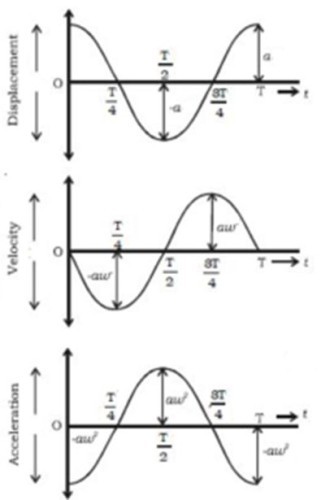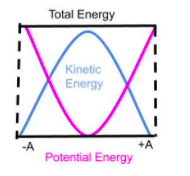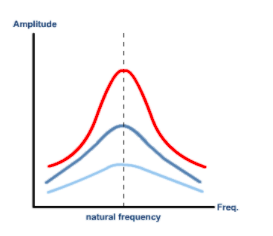-
What are the conditions for simple harmonic motion?
 Acceleration must be proportional to its displacement from the equilibrium point It must act towards the equilibrium point (frictionless)
Acceleration must be proportional to its displacement from the equilibrium point It must act towards the equilibrium point (frictionless) -
What is the constant of proportionality linking acceleration and x?-w^2 or -k/m
-
F resultant equation for SHMFres = -kx
-
Acceleration for SHMa = (-k/m)x = -(w^2)x
-
What is x as a function?x = Acos(wt) = Asin(wt) w = s^-1 A = m, amplitude x = m t = s
-
Equation for max speed in SHMMax speed = wA w = s^-1 A - m
-
How to calculate maximum acceleration?Max acceleration = (w^2)A
-
graphs of x(t), v(t), a(t)

-
v(t) equationx(t) = Acos(wt) (dx/dt) = -wAsin(wt)
-
a(t) equation(dv/dt) = (d2x/dt2) = -(w^2)Asin(wt)
-
When displacement is at the maxv = 0, a is at max acceleration still occurs as there is still force acting on the object
-
if x is positive ... if x is negative ...extension compression (if there is no friction) in SHM the object will continuously go backwards and forwards
-
Is one oscillation completed in the same amount of time regardless of amplitude?Yes, though in small oscillations there is less to travel there is also less speed and the opposite for large oscillations
-
Time period equation for SHM systemT = 2pi/w =2pi(square root(m/k))
-
Frequency equation for SHM system1/T = w/2pi
-
angular frequency equationw = 2pif
-
small angle approximation for sinxsin x ~ x (radians)
-
small angle approximation for cos x1 - ( x^2 /2 )
-
What happens when v = 0/ v is greatestwhen v = 0 the acceleration is at its greatest when v is at the greqatest the acceleration = 0 , as at this point when v = 0 x is the greatest and so acceleration is greatest when v is the greatest x = 0 so acceleration = 0
-
What happens at the max/min displacement?The object is stationary but accelerating largest possible acceleration at extreme points as F is proportional to x so at extreme points the force is at its greatest
-
What is time period irrespecitve of?amplitude
-
What happens to the time period if you increase the mass?increas time period so greater oscillation
-
What happens when there are 3 springs in series?spring constant is k/3 so time period is greater so there is a slower/greater oscillation when they are in parallel it is 3k so time period is less so oscillation is smaller
-
Why SHM?Approximately same for small displacements for almost anything, because any general f(x) is approximately linear for small x As any complex mostion, too complex to analyse can be decomposed into sine and cosinr SHM oscillations which can be analysed
-
The graph for potential energy and kinetic energy against displacement, for a SHM system?

-
Equation for total energy in SHMEtotal = KE + EPE Since no external object does work on it, we'd expect the system's energy to be unchanging
-
When is max KE and max EPE? When is min KE and min EPE?max KE when v is greatest max EPE when x is greatest 0 KE when v is 0 0 EPE when x is 0
-
equation for max EPE in SHMPEmax = 1/2 x k x A^2
-
Total energy equation for SHM1/2 x k x A^2
-
What does zero PE imply?max KE
-
Does EPE and KE vary during an oscillation?Between zero and minimum values
-
What is the equation for the time period of a simple harmonic pendulum?T = 2pi(square root(l/g)) g = ms^-2 l - m T - s
-
Free vibrationsThe frequency of a system tends to vibarte at in a free vibration, called the natural frequency
-
Dampingoccurs when an opposing force dissipates energy to the surroundings
-
Critical dampingreduced the amplitude to zero in the quickest time
-
overdampingwhen the damping force is too strong and it returns to equilibrium slowly without oscillation
-
underdampingwhen the damping force is too weak and it oscillates with exponentially decreasing amplitude
-
what happens to a vibration with gretaer damping?
 for a vibration with gretaer damping, the amplitude is lower at all frequencies due to the greater energy losses from the system the resonant peak is broader because of the damping
for a vibration with gretaer damping, the amplitude is lower at all frequencies due to the greater energy losses from the system the resonant peak is broader because of the damping -
Forced vibrationsa driving force causes the system to vibrate at a different frequency for higher driving frequencies, the phase difference between the driver and the oscillations rise to pi radians for lower frequencies, the oscillations are in phase with the driving force when resonance occurs which is when it most efficiently transfers energy to the system, the phase difference will be pi/2 radians
-
What are some implications of resonance in real life?Implications of resonance include that soilders must break stop when crossing bridges and vehicles must be designed so there are no unwanted vibrations
-
What is meant by forced vibrations?
A system made to oscillate by a periodic external force
-
Epe equation
0.5ke^2 = 0.5Fe
-
A limitation that applies to the pendulum when the time period equation for a pendulum is used
Amplitude is smaller

